Cdc20 Is Critical for Meiosis I and Fertility of Female Mice
Chromosome missegregation in germ cells is an important cause of unexplained infertility, miscarriages, and congenital birth defects in humans. However, the molecular defects that lead to production of aneuploid gametes are largely unknown. Cdc20, the activating subunit of the anaphase-promoting complex/cyclosome (APC/C), initiates sister-chromatid separation by ordering the destruction of two key anaphase inhibitors, cyclin B1 and securin, at the transition from metaphase to anaphase. The physiological significance and full repertoire of functions of mammalian Cdc20 are unclear at present, mainly because of the essential nature of this protein in cell cycle progression. To bypass this problem we generated hypomorphic mice that express low amounts of Cdc20. These mice are healthy and have a normal lifespan, but females produce either no or very few offspring, despite normal folliculogenesis and fertilization rates. When mated with wild-type males, hypomorphic females yield nearly normal numbers of fertilized eggs, but as these embryos develop, they become malformed and rarely reach the blastocyst stage. In exploring the underlying mechanism, we uncover that the vast majority of these embryos have abnormal chromosome numbers, primarily due to chromosome lagging and chromosome misalignment during meiosis I in the oocyte. Furthermore, cyclin B1, cyclin A2, and securin are inefficiently degraded in metaphase I; and anaphase I onset is markedly delayed. These results demonstrate that the physiologically effective threshold level of Cdc20 is high for female meiosis I and identify Cdc20 hypomorphism as a mechanism for chromosome missegregation and formation of aneuploid gametes.
Published in the journal:
. PLoS Genet 6(9): e32767. doi:10.1371/journal.pgen.1001147
Category:
Research Article
doi:
https://doi.org/10.1371/journal.pgen.1001147
Summary
Chromosome missegregation in germ cells is an important cause of unexplained infertility, miscarriages, and congenital birth defects in humans. However, the molecular defects that lead to production of aneuploid gametes are largely unknown. Cdc20, the activating subunit of the anaphase-promoting complex/cyclosome (APC/C), initiates sister-chromatid separation by ordering the destruction of two key anaphase inhibitors, cyclin B1 and securin, at the transition from metaphase to anaphase. The physiological significance and full repertoire of functions of mammalian Cdc20 are unclear at present, mainly because of the essential nature of this protein in cell cycle progression. To bypass this problem we generated hypomorphic mice that express low amounts of Cdc20. These mice are healthy and have a normal lifespan, but females produce either no or very few offspring, despite normal folliculogenesis and fertilization rates. When mated with wild-type males, hypomorphic females yield nearly normal numbers of fertilized eggs, but as these embryos develop, they become malformed and rarely reach the blastocyst stage. In exploring the underlying mechanism, we uncover that the vast majority of these embryos have abnormal chromosome numbers, primarily due to chromosome lagging and chromosome misalignment during meiosis I in the oocyte. Furthermore, cyclin B1, cyclin A2, and securin are inefficiently degraded in metaphase I; and anaphase I onset is markedly delayed. These results demonstrate that the physiologically effective threshold level of Cdc20 is high for female meiosis I and identify Cdc20 hypomorphism as a mechanism for chromosome missegregation and formation of aneuploid gametes.
Introduction
Mitotic checkpoint genes are believed to be prime targets for deregulation in human infertility [1]. The mitotic checkpoint constitutes an intricate molecular network that ensures accurate chromosome segregation by coordinating metaphase-to-anaphase progression with the establishment of bipolar spindle attachment and metaphase plate alignment of all mitotic chromosome pairs [2]. At early stages of mitosis, various mitotic checkpoint proteins, including members of the Bub and Mad protein families, concentrate at unattached kinetochores to generate a diffusible signal that inhibits the anaphase-promoting complex or cyclosome (APC/C), a large E3 ubiquitin ligase that drives metaphase-to-anaphase transition by catalyzing the ubiquitination and degradation of cyclin B1 and securin [3]. Although the exact composition of the inhibitory signal remains a major subject of investigation, it is believed to contain Bub3-bound BubR1 and Mad2 that has been primed by kinetochore-associated Mad1-Mad2 to stably interact with the APC/C activating subunit Cdc20 [4], [5], [6]. Upon attachment and alignment of the last chromosome pair, the inhibitory signal is quenched and APC/C activated through release of Cdc20 inhibition, triggering the ubiquitination and destruction of cyclin B1 and securin. Separase, a protease that is held in an inactive state by securin and cyclin B1/Cdk1, is then allowed to cleave the Scc1 subunit of the cohesin complex that holds sister chomatids together, inducing the physical separation of sister chromatids by spindle forces [7], [8].
A thorough assessment of the role of mitotic checkpoint genes in gametogenesis and infertility has not been possible because complete inactivation of mammalian mitotic checkpoint genes invariably disrupts the chromosome segregation process so severely that cells cannot survive [2], [9]. In vitro studies of primary mouse oocytes in which key mitotic checkpoint proteins were depleted by morpholinos or RNA interference have pointed to an importance of several mitotic checkpoint proteins during the first meiotic division. For instance, sustained prophase I arrest of primary oocytes depends on stabilization of the Cdc20-related APC/C coactivator Cdh1 by BubR1 [10]. BubR1 retains control of Cdh1 stability after hormone-induced resumption of meiosis, thereby allowing APC/CCdh1-mediated securin degradation and progression through prometaphase I. Interestingly, BubR1 protein levels have been shown to decline in ovary and testis as normal mice age, which combined with the observation that mutant mice with low amounts of BubR1 are infertile, has led to speculation that BubR1 might be a key determinant of age-related meiotic errors in germ cells [11]. While APC/CCdh1 regulates early meiotic events in mice [10], [12], Cdc20 knockdown experiments in primary oocytes indicate that APC/CCdc20 is active in late meiosis I [10], where it is responsible for driving oocytes into anaphase via the destruction of cyclin B1and securin, much like mitosis in somatic cells [13]. Coordination of APC/CCdc20 activation with proper kinetochore-microtubule attachment in meiosis I is dependent on the mitotic checkpoint proteins Mad2 and Bub1, as depletion or expression of dominant-negative mutants of these proteins in primary mouse oocytes causes chromosome missegregation [14], [15], [16], [17].
Whereas the depletion studies in primary mouse oocytes identify Cdc20 and Cdh1 as critical regulators of the first meiotic division, testing whether the functions unveiled in vitro operate in vivo remains an important challenge. Furthermore, it remains unknown whether Cdc20 and Cdh1 are also important for male meiosis I or stages of male and female gametogenesis other than meiosis I. Importantly, for Cdc20 and Cdh1 to be candidate infertility genes, one would expect their dysfunction to reduce fertility without compromising overall health and viability. Addressing these issues has been hampered by the embryonic lethality caused by inactivation of Cdh1 and Cdc20 in mice, with Cdh1-null embryos dying at mid-gestation due to placental defects [18], [19] and Cdc20-null embryos at the two-cell stage due to permanent metaphase arrest [18].
In the present study, we bypassed the problem of early embryonic lethality of Cdc20 knockout mice by generating mutant mouse strains in which the dose of Cdc20 is reduced in graded fashion, enabling us to examine the physiological relevance of this APC/C cofactor. Our findings reveal that the threshold for pathophysiology is lowest in the female germline. We demonstrate that while both mitotic and meiotic divisions of male and female germ cells are characterized by inaccurate chromosome segregation and aneuploidization, only female meiosis I is so severely affected that almost exclusively aneuploid mature eggs are generated. We show that these eggs fertilize normally, but that the resulting zygotes die after the first few embryogenic divisions.
Results
Generation of Mutant Mice with Graded Reduction of Cdc20
A series of mutant mouse strains in which expression of Cdc20 is gradually reduced was generated by using various combinations of wild-type (Cdc20+), hypomorphic (Cdc20H) and knockout (Cdc20−) alleles (Figure 1A–1D). The Cdc20H allele was produced by targeted insertion of a neomycin phosphotransferase II (neo) gene cassette into the third intron of the Cdc20 gene (Figure 1A). The neo gene contains a cryptic exon with stop codons in all three reading frames, thereby considerably reducing the amount of wild-type protein produced by targeted allele [11], [20], [21], [22]. The Cdc20− allele was from gene trap mouse embryonic stem (ES) cell clone XE368 (Figure 1B). Previously, it has been shown that this gene trap allele is the equivalent of a null allele and that embryos that are homozygous for this allele arrest and die at the two-cell stage of development [23]. In contrast, Cdc20+/H, Cdc20+/−, Cdc20H/H and Cdc20−/H mice were viable and had no overt phenotypes. Western blot analysis demonstrated that Cdc20+/H, Cdc20+/−, Cdc20H/H and Cdc20−/H ovary and testes had a graded reduction of Cdc20 protein (Figure 1E and 1F). Western blot analysis of spleen, bone marrow, and mouse embryonic fibroblast extracts of Cdc20+/+ and Cdc20−/H mice suggested that the observed Cdc20 protein reductions are universal, irrespective of tissue or cell type (Figure 1G, and data not shown).
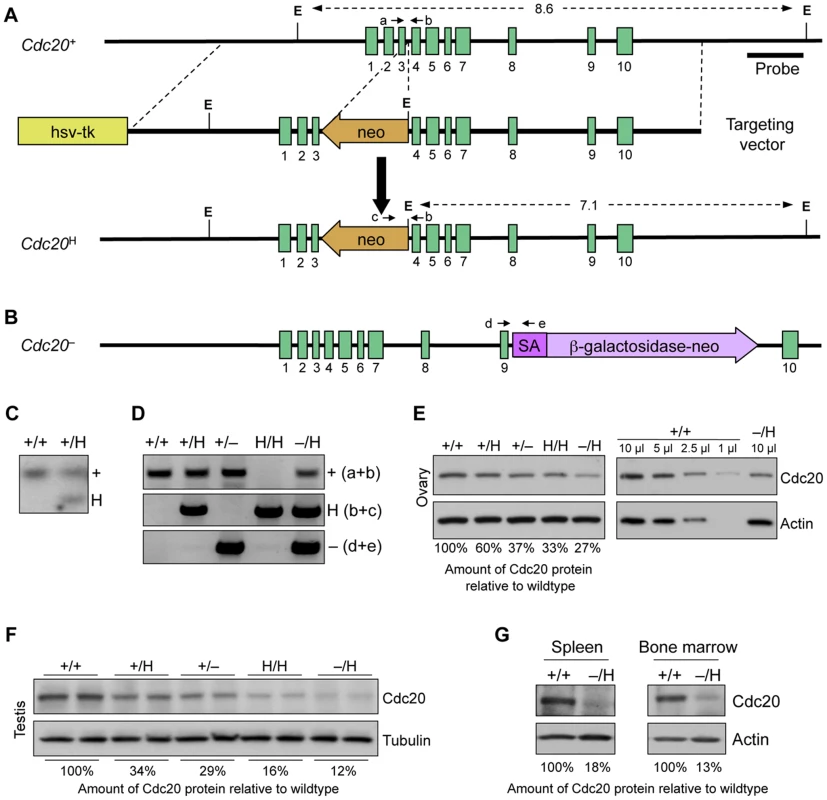
Cdc20 Hypomorphic Females Are Infertile or Subfertile Despite Normal Oogenesis
While establishing cohorts of Cdc20 mutant mice for long-term observation, we noticed that Cdc20−/H females yielded little or no offspring, which prompted us to measure the impact of graded reduction in Cdc20 expression on female fertility. Two-month-old Cdc20+/+, Cdc20+/H, Cdc20+/−, Cdc20H/H and Cdc20−/H mice were bred to Cdc20+/+ males of the same age and the number of litters and pups produced per female was recorded for three months. Despite normal copulation rates (Figure 2A), Cdc20−/H females produced on average about 4-fold fewer litters than females of the other genotypes (Figure 2B), while the average number of pups was about 15-fold lower (Figure 2C). Notably, of the seven Cdc20−/H females in the study, four failed to produce any offspring (Figure 2D). Only Cdc20+/− and Cdc20+/H embryos can be produced by Cdc20−/H females bred to Cdc20+/+ males. Importantly, pups of these genotypes were produced at normal rates when Cdc20+/−, Cdc20+/H and Cdc20H/H females were bred to Cdc20+/+ males (Figure 2C and 2D), indicating that the failure of Cdc20−/H females to produce offspring with Cdc20+/+ males was not due to the genotype of the embryos produced. Together, the above data demonstrate that Cdc20−/H females are either infertile or severely subfertile. The Cdc20 threshold level for fertility problems is remarkably sharp because Cdc20H/H females, which produce slightly more Cdc20 than Cdc20−/H females, have normal fertility (Figure 2A–2D). Ten of 10 Cdc20−/H males were fertile and produced on average 7 pups per litter (data not shown), indicating that gametogenesis in male mice has a lower dependence on Cdc20 than the female reproductive system.
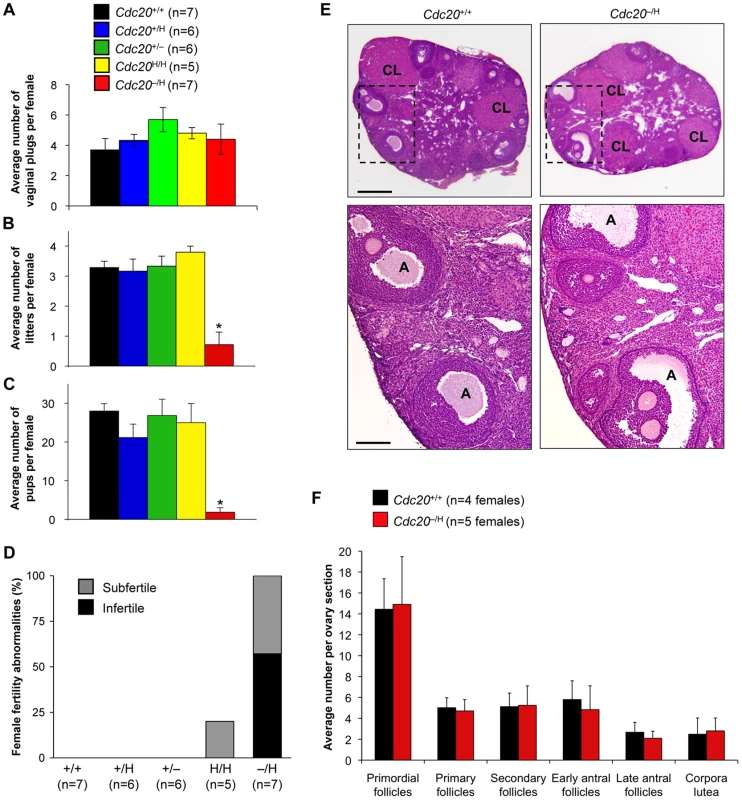
To study how Cdc20 deficiency impedes female fertility, we screened hematoxylin-eosin ovary sections of sexually mature Cdc20−/H females for overt defects in oogenesis. However, no apparent morphological differences were found (Figure 2E). Cdc20−/H and Cdc20+/+ ovary sections contained similar amounts of primordial, primary, secondary and antral follicles, as well as similar numbers of mature oocytes and corpora lutea (Figure 2E and 2F). These data indicated that the fertility problem of Cdc20−/H females is not due to a failure to produce, mature or ovulate oocytes.
Fertilized Eggs from Cdc20 Hypomorphic Females Fail to Develop into Blastocysts
To explore preimplantation embryonic development, Cdc20−/H and Cdc20+/+ females were naturally mated with Cdc20+/+ males and embryos were collected at day 3.5 of development (E3.5). While 93% of embryos collected from Cdc20+/+ females were at the expected blastocyst stage, only 15% of Cdc20−/H females had reached this stage (Figure 3A and 3B). The remaining embryos were either in the one- to four-cell stage or completely degenerated. Notably, the total number of embryos produced by Cdc20+/+ and Cdc20−/H females was the same (Figure 3B), indicating Cdc20−/H females had normal fertilization rates and were capable of ovulating normal numbers of mature oocytes. Furthermore, the number of normal blastocysts produced by Cdc20−/H females is similar to the number of live born pups these females produce, indicating that embryos that attain the blastocyst stage were capable of developing into healthy animals.
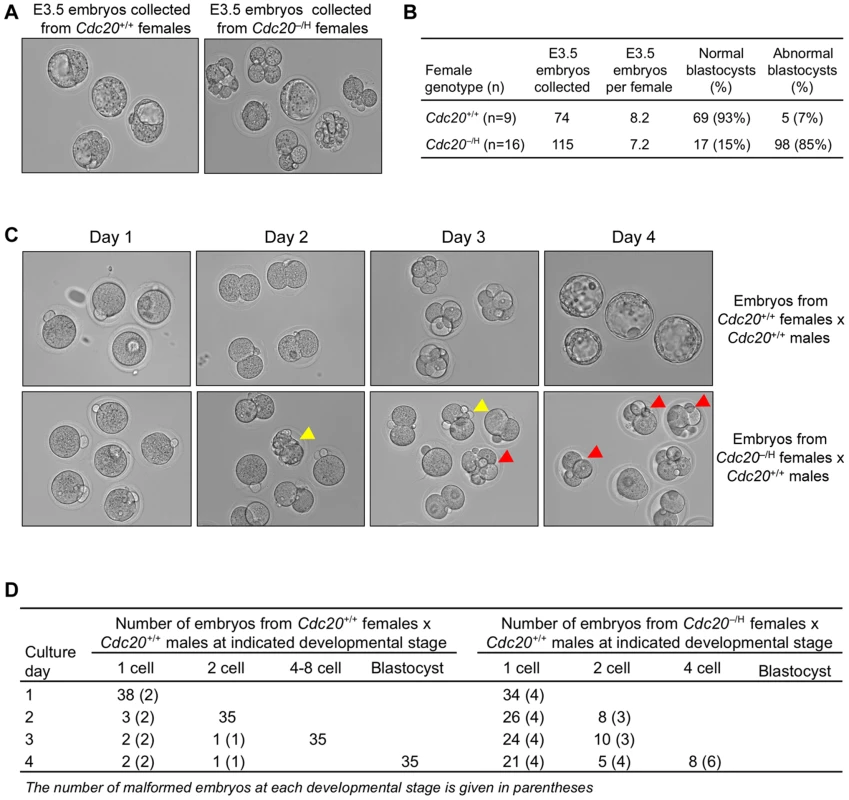
The above data indicated that the majority of eggs produced by Cdc20−/H females stop proliferating after the first cell divisions of the preimplantation period. To confirm this and to characterize preimplantation embryo development, we collected one-cell stage embryos from Cdc20+/+ and Cdc20−/H females crossed with Cdc20+/+ males and monitored their development in vitro. As expected, most embryos from Cdc20+/+ females developed to the blastocyst stage within four days (Figure 3C and 3D). In contrast, none of the embryos from Cdc20−/H females developed beyond the 4-cell stage, with the majority of embryos remaining at the one cell stage. This growth phenotype is remarkably different from that of Cdc20−/− embryos, which typically arrest in metaphase at the two-cell stage due to inability to degrade cyclin B1 and securin in the absence of Cdc20 [23]. Importantly, one cell stage embryos from Cdc20−/H females are either Cdc20+/− or Cdc20+/H. Embryos of these genotypes show normal survival rates when derived from Cdc20+/− and Cdc20+/H females and Cdc20+/+ males (see Figure 2B and 2C). Together, these data suggested that the early death of the embryos produced by Cdc20−/H females is due to defects introduced during oogenesis.
Cdc20 Hypomorphic Females Produce Aneuploid Oocytes and Embryos
We hypothesized that Cdc20 hypomorphism promotes chromosome missegregation during oogenesis, resulting in production of aneuploid embryos that fail to thrive. To test this idea, we collected one-cell stage embryos from Cdc20+/+, Cdc20H/H and Cdc20−/H females mated with Cdc20+/+ males and prepared metaphase spreads for chromosome counts. We found that 11% of embryos from Cdc20+/+ females were aneuploid compared to 27% and 78% of embryos from Cdc20H/H and Cdc20−/H females, respectively (Figure 4A). Aneuploidy was strongly biased toward loss of chromosomes, irrespective of Cdc20 genotype. Importantly, nearly 30% of aneuploid embryos from Cdc20−/H females had 14 to 19 extra chromosomes (Figure 4A and 4D). We noted that these embryos contained a very high proportion of chromosome pairs (Figure 4D), which suggested that they originated from mature oocytes that had failed to complete meiosis II after fertilization.
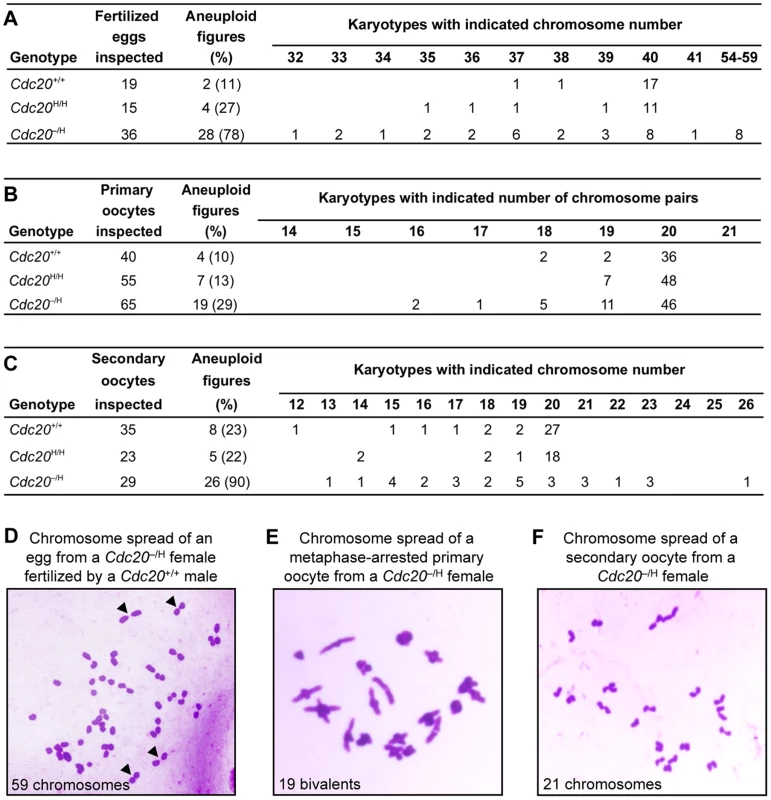
Next, we determined whether Cdc20 hypomorphism also leads to erroneous chromosome segregation at earlier stages of oogenesis. During embryogenesis, primordial germ cells migrate to the developing gonad to form oogonia, which expand in number through a series of mitotic divisions before differentiating into primary oocytes that arrest in prophase of meiosis I. To determine whether the early mitotic divisions might contribute to the aneuploidy seen in fertilized eggs, primary oocytes were harvested from ovaries of Cdc20+/+, Cdc20H/H and Cdc20−/H females. In mice, primary oocytes normally have 20 paired chromosomes, called bivalents. Primary oocytes from Cdc20+/+ and Cdc20H/H females had abnormal numbers of bivalents in 10% and 13% of spreads, respectively (Figure 4B). In contrast, primary oocytes from Cdc20−/H females had considerably more aneuploidy, with 29% of spreads showing abnormal numbers of bivalents (Figure 4B and 4E). These spreads showed no evidence of precocious separation of bivalents, indicating that formation of chiasmata was intact at low Cdc20 levels.
Although Cdc20 insufficiency causes aneuploidy during the early mitotic divisions of oogenesis, aneuploidy rates of primary oocytes were substantially lower than those of fertilized eggs. To explore whether additional aneuploidy occurred during meiosis I, we prepared metaphase spreads from secondary oocytes of Cdc20+/+, Cdc20H/H and Cdc20−/H females and counted chromosomes. We found that aneuploidy rates of secondary oocytes from Cdc20+/+ and Cdc20H/H females increased modestly to 23% and 22%, respectively (Figure 4C). This verified that the level of Cdc20 protein in oocytes from Cdc20H/H females was enough to let the chromosomes separate correctly at meiosis I. In contrast, a much more dramatic increase was recorded for secondary oocytes from Cdc20−/H females, with 90% of spreads showing numerical chromosome abnormalities (Figure 4C and 4F).
To obtain direct evidence for chromosome missegregation during the first meiotic division of Cdc20 insufficient oocytes, we monitored chromosome movements of Cdc20+/+ and Cdc20−/H primary oocytes during meiosis I using time-lapse fluorescence imaging (Figure 5A). To visualize chromosomes we injected in vitro transcribed H2B-mRFP mRNA into the oocytes. In this setup, oocytes from Cdc20−/H females displayed much higher rates of chromosome missegregation than oocytes from Cdc20+/+ females (Figure 5B). The two types of errors that were observed are congression failure and chromosome lagging, of which the latter defect was clearly most frequent. Particularly, chromosome lagging incidents involving three or more lagging chromosomes occurred at much higher rates in Cdc20−/H oocytes (Figure 5B and 5C, and Video S1 and Video S2). Thus, consistent with our chromosome counts on secondary oocytes, chromosome segregation errors during meiosis I contribute considerably to the infertility phenotype of Cdc20−/H females.
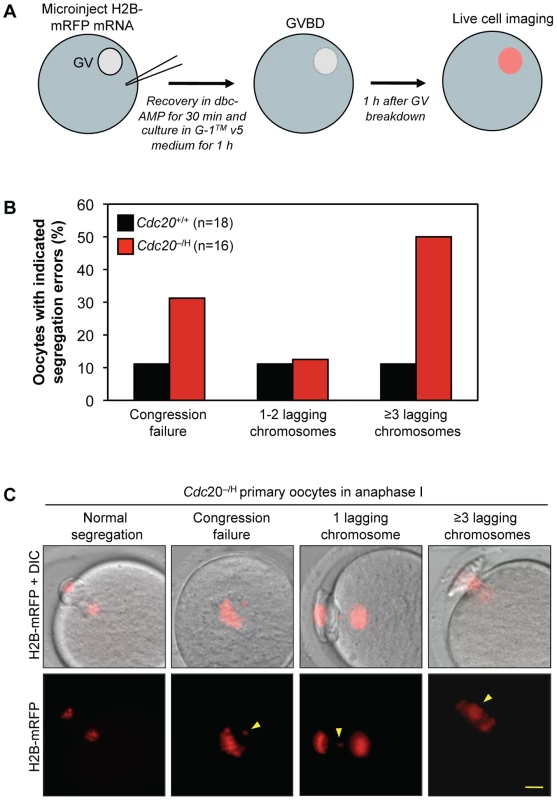
Cdc20 Hypomorphism Prolongs Metaphase I
Orderly progression of oocytes through meiosis I is controlled by the APC/C, which prompted us to examine whether timing of meiosis I is deregulated at low Cdc20 levels. Cdc20+/+ and Cdc20−/H oocytes were injected with H2B-mRFP mRNA and observed by time-lapse microscopy while executing meiosis I. We found that the time from germinal vesicle breakdown (GVBD) to metaphase was similar in Cdc20+/+ and Cdc20−/H oocytes (Figure 6A and 6B), which is consistent with the notion that Cdh1 functions as the primary ACP/C activator during the early stages of meiosis I [12]. However, the average time from metaphase entry to anaphase onset was about two times longer in Cdc20−/H oocytes than in Cdc20+/+ oocytes (Figure 6A and 6B). This delay was unlikely to be due to chromosome segregation errors as oocytes with misaligned or lagging chromosomes were excluded from the analysis. Consistent with delayed metaphase progression, PBE extrusion was markedly delayed in Cdc20−/H oocytes (Figure 6C). Taken together, these data indicate that the timing of metaphase I is subject to deregulation when the amount of Cdc20 protein is limited.
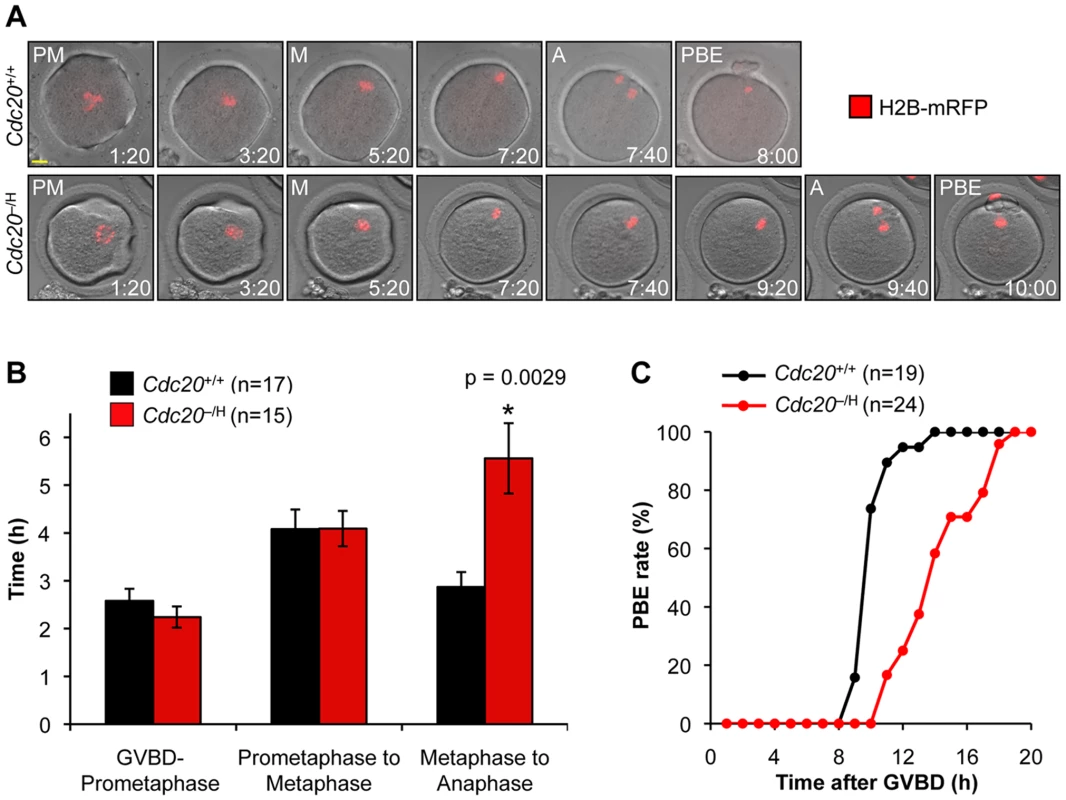
Low Cdc20 Impairs Degradation of Mitotic Cyclins and Securin in Metaphase I
To explore the mechanism underlying the chromosome missegregation phenotype of Cdc20−/H primary oocytes, we measured the rate of degradation of two key APC/CCdc20 substrates, cyclin B1 and securin [12]. In the first set of experiments, we injected Cdc20−/H and Cdc20+/+ primary oocytes with mRNA encoding cyclin B1-EGFP and monitored the degradation of fluorescent protein by live-cell imaging. Oocytes were coinjected with H2B-mRFP mRNA to accurately assess the timing of cyclin B1-EGFP degradation. As illustrated in Figure 7A and 7B, Cdc20+/+ oocytes degraded most of their cyclin B1-EGFP during late prometaphase and early metaphase. Cdc20−/H oocytes entered metaphase I around the same time as Cdc20+/+ oocytes. However, they did so with relatively high cyclin B1-EGFP protein levels and completed substrate degradation ∼2 h later than Cdc20+/+ oocytes. To confirm that cyclin B1 degradation was delayed, we used indirect immunofluorescence to measure endogenously expressed cyclin B1 levels of Cdc20+/+ and Cdc20−/H oocytes in metaphase I. As shown in Figure 7C and 7D, cyclin B1 levels were indeed higher in Cdc20−/H oocytes than in Cdc20+/+ oocytes. Importantly, these oocytes also showed elevated levels of phosphorylated Cdk substrates (Figure 7C and 7D), suggesting that the rise in cyclin B1 expression resulted in increased cyclin B1-Cdk1 activity in metaphase I.
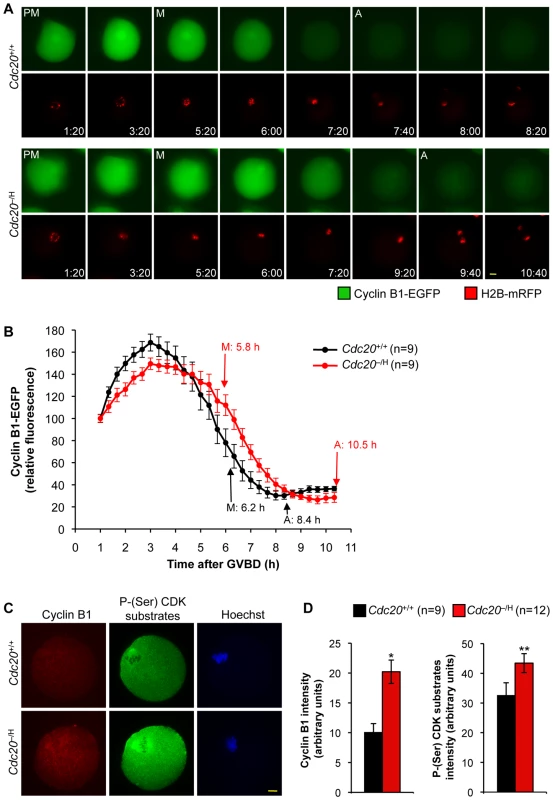
Next, we coinjected securin-EYFP [24] and H2B-mRFP mRNA into Cdc20−/H and Cdc20+/+ primary oocytes. We noticed that expression of securin-EYFP protein markedly inhibited PBE even in Cdc20+/+ oocytes (data not shown), but were able to control this problem by reducing the concentration of the injected securin-EYFP mRNA. In Cdc20+/+ oocytes, onset of securin-EYFP degradation typically coincided with metaphase entry and then rapidly progressed until anaphase onset (Figure 8). In Cdc20−/H oocytes, however, securin-EYFP protein degradation did not start until mid metaphase. Degradation not only started later, but was also less efficient, resulting in anaphase entry with higher than normal levels of securin-EYFP. In a recent study, McGuinness et al. demonstrated that the timing of cyclin A2 degradation in primary oocytes is similar to that of securin [17], which is surprising given that mitotic cells fully degrade this cyclin in prometaphase. In light of these findings, we wanted to examine whether the degradation of cyclin A2 was impaired in Cdc20−/H oocytes. As for securin-EYFP, cyclin A2-EGFP inhibited PBE in Cdc20+/+ oocytes when expressed at high levels (data not shown), but again we were able to control this problem by injecting low amounts of transcript. Consistent with the earlier data [17], Cdc20+/+ primary oocytes rapidly destroyed cyclin A2-EGFP in metaphase I (Figure 9). In contrast, both the onset and the rate of cyclin A2-EGFP were substantially reduced in Cdc20−/H oocytes. Strikingly, Cdc20−/H oocytes again entered anaphase I with higher substrate levels than Cdc20+/+ oocytes. Taken together, the above data demonstrate that multiple APC/C substrates are inefficiently degraded when Cdc20 levels are low, raising the possibility that persistent cyclin-CDK activity in metaphase I might underlie, at least in part, the chromosome missegregation phenotype of Cdc20−/H oocytes.
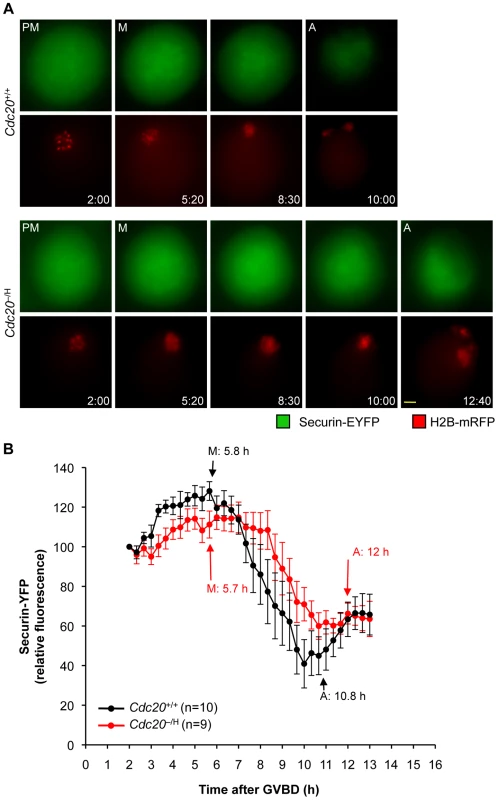
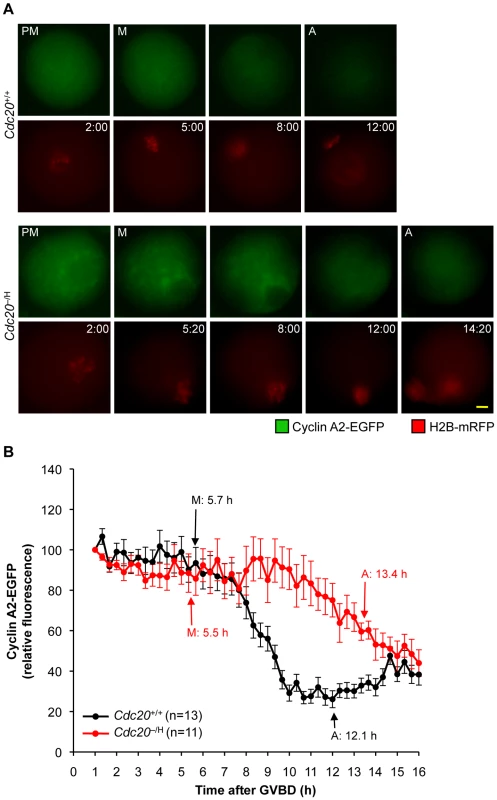
It is conceivable that delayed cyclin and securin degradation impairs separase activation, and therefore proper cleavage of cohesin along chromosome arms of bivalents prior to anaphase onset. To test for this possibility, we collected Cdc20−/H and Cdc20+/+ primary oocytes, cultured them in vitro until they arrested in metaphase II and then stained chromosomes for the presence of Rec8, a meiosis specific component of the cohesin complex [25], [26]. While Rec8 staining was readily detectable along chromosome arms of metaphase I chromosomes, no such staining was detectable in metaphase II oocytes, irrespective of Cdc20 genotype (Figure S1), implying that Cdc20−/H oocytes generated sufficient separase activity for complete cleavage of Rec8. Furthermore, core mitotic checkpoint proteins that are involved in kinetochore assembly, kinetochore-microtubule and/or spindle assembly checkpoint activation, such as Bub1, BubR1, and Mad2, were normally localized at kinetochores of Cdc20−/H primary oocytes (Figure S2).
Aneuploidy Rates during Male Meiosis I Are Relatively Low
Cdc20−/H males appeared to have normal fertility, predicting that male meiosis I is much less sensitive to Cdc20 hypomorphism. To verify this, we prepared chromosome spreads of testicular cell suspensions from Cdc20+/+ and Cdc20−/H mice and performed chromosome counts on secondary spermatocytes. Although aneuploidy was 5-fold higher at low than at normal Cdc20 levels (Figure 10A), secondary spermatocytes of Cdc20−/H males had much lower aneuploidy rates than secondary oocytes of Cdc20−/H females (19% versus 90%). Chromosome counts on primary spermatocytes revealed a 4-fold increase in aneuploidy due to Cdc20 hypomorphism, with 12% of spreads showing abnormal numbers of bivalents (Figure 10B), suggesting that the mitotic divisions that spermatogonia have to undergo to produce primary spermatocytes are error prone at low Cdc20 levels. The rather modest increase in aneuploidy from 12% to 19% as primary spermatocytes develop into secondary spermatocytes underscores that the fidelity of male meiosis I remains quite high at low Cdc20 levels. Furthermore, histology and apoptosis rates were normal in testis of Cdc20−/H males, as judged by hematoxylin and eosin (H/E) and TUNEL staining of testis sections, respectively (Figure 10C–10E).
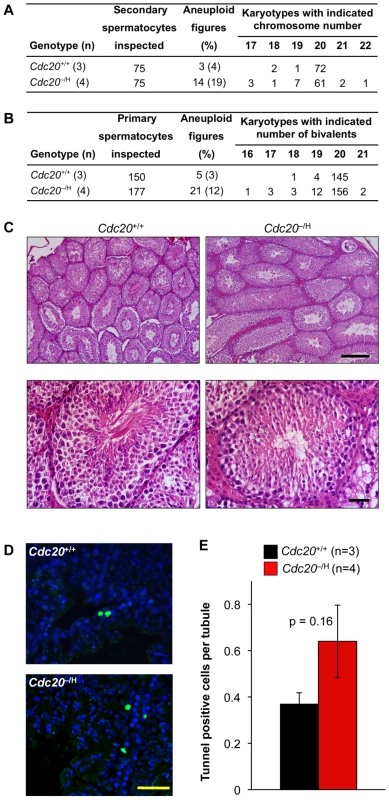
Discussion
By generating a series of mice with graded reduction in Cdc20 levels, we discovered a remarkably sharp threshold for Cdc20 expression in female germ cells below which chromosome segregation errors occur at high frequency, leading to production of aneuploid eggs that are fertilization competent but fail to progress beyond the first few embryonic divisions. On the other hand, low Cdc20 levels are well tolerated by somatic tissues and have no overt impact on the overall health and life expectancy of mice. These findings raise the intriguing possibility that hypomorphic Cdc20 alleles may be responsible for unexplained fertility problems in otherwise healthy women.
Because aneuploidy has been associated with reduced cell growth and survival [27], [28], one might have predicted that oogenesis would be severely disrupted in Cdc20 hypomorphic mice. Surprisingly, however, we did not observe significant alterations in the number and morphology of follicles and corpora lutea in these mice. These findings suggest that cellular pathways that might inhibit cell proliferation or induce cell death in response to chromosome missegregation are either not active in female germ cells or require a higher threshold for activation than in somatic cells [29]. Our finding that folliculogenesis was unperturbed was also unexpected in light of studies showing that depletion of Cdc20 from primary oocytes by a morpholino causes metaphase I arrest [12]. For somatic cells it has been estimated that metaphase arrest requires a 20-fold or higher reduction in cellular Cdc20 levels [30]. We suspect that morpholino treatment reaches this level of reduction, whereas Cdc20 hypomorphism does not.
In systematically karyotyping primary and secondary oocytes and fertilized eggs, we discovered that Cdc20 hypomorphism promotes aneuploidization at different stages of oogenesis, involving both mitotic and meiotic divisions. The highest increase in aneuploidy, however, occurred in the first meiotic division. The most prominent segregation errors that we observed during meiosis I are chromosome misalignment and chromosome lagging. Previous studies in HeLa and Ptk1 cells uncovered that cyclin A2 overexpression causes chromosome misalignment [31], suggesting that alignment defects in Cdc20 hypomorphic oocytes might be related to their inability to destroy cyclin A2 in a timely fashion. Resolution of chiasmata requires removal of cohesin from chromosome arms, which involves cleavage of the cohesin subunit Rec8 by separase [32]. In turn, activation of separase requires APC/C-mediated degradation of securin and cyclin B, both of which are delayed in Cdc20 hypomorphic primary oocytes. Thus, it is possible that Cdc20 hypomorphic oocytes do not have enough APC/C activity to fully activate separase and properly resolve chiasmata, thereby prompting chromosome lagging and aneuploidization. Arguing against this explanation is the fact that chromosome spreads of Cdc20 hypomorphic metaphase II oocytes did not contain any bivalents or chromosomes that stained positive for Rec8 along chromosome arms. Alternatively, chromosome lagging in Cdc20 hypomorphic oocytes might be caused by microtubule-kinetochore attachment defects [33], [34]. For instance, delayed degradation of cyclin B1 (or other APC/C substrates) might promote such defects by disrupting key components of the mechanisms that establish syntelic attachment or that correct merotelic or amphitelic attachments. We found that two mitotic checkpoint proteins required for proper microtubule-chromosome attachment, Bub1 and BubR1, were normally localized at kinetochores of Cdc20 hypomorphic oocytes. However, it should be emphasized that microtubule-kinetochore attachment is a complex process requiring many different proteins, any of which could be deregulated in our mutant oocytes. Interestingly, in somatic cells, a small fraction of Cdc20 accumulates at kinetochores during mitosis [35], which raises the possibility that Cdc20 might have a more direct role in establishing proper microtubule-kinetochore attachments.
Our finding that a significant percentage of Cdc20−/H primary oocytes were already aneuploid before resuming meiosis I suggests that the mitotic divisions by which primordial germ cells develop into primary oocytes are prone to chromosome missegregation when Cdc20 levels are below a certain threshold. Due to technical limitations, it was not possible to verify this experimentally. The precise impact of Cdc20 hypomorphism on meiosis II is difficult to decipher, largely because nearly all oocytes are aneuploid after meiosis I. However, the presence of a sizeable amount of near triploid fertilized eggs strongly suggests that Cdc20 insufficiency can cause failure of maternal sister chromatids to separate during meiosis II, although we note that it cannot be excluded that the preexisting aneuploidy rather than the low Cdc20 levels drive the separation defect. It could be argued that embryos from Cdc20−/H females bred to Cdc20+/+ males might fail to thrive due to a potential lack of Cdh1 expression in the early embryos, rendering embryonic mitotic divisions particularly dependent on Cdc20. However, this explanation seems unlikely because Cdh1 has been shown to be expressed in two-cell stage mouse embryos [23]. Furthermore, it should be considered that the embryos from Cdc20−/H females bred to Cdc20+/+ males that fail to thrive had either Cdc20+/− or Cdc20+/H genotypes. Embryos of both these genotypes show normal survival rates when derived from Cdc20+/− and Cdc20+/H females crossed with Cdc20+/+ males (Figure 2B and 2C), further supporting the idea that aneuploidy acquired during oogenesis is largely responsible for the early death of embryos from Cdc20−/H females.
An intriguing finding was that the fertility problems of Cdc20−/H mice are restricted to females, even though our analysis of aneuploidy in primary and secondary spermatocytes demonstrated that mitotic and meiotic divisions of male germ cells are prone to aneuploidy. However, the key difference between males and females that probably accounts for their distinct fertilities is that the rate of aneuploidization during meiosis I is substantially higher in females than in males. Why might female meiosis I be more sensitive to Cdc20 hypomorphism? A recent study of mouse oocytes suggests that mammals have a unique mechanism for control of meiosis I in that they require APC/CCdh1 activity for progression through prometaphase I [12]. Cdc20 is targeted for destruction by this early APC/C activity and needs to be re-synthesized during metaphase I to enable anaphase onset. It is possible that Cdc20 destruction in prometaphase I only occurs in females, perhaps creating a higher degree of Cdc20 insufficiency in oocytes than in spermatocytes.
Materials and Methods
Generation of Cdc20 Mutant Mice
The gene targeting procedure used to produce the hypomorphic Cdc20 allele (H) was as previously described [22]. To generate the targeting construct, Cdc20 gene fragments of 3.9 kb (spanning exons 1–3) and 4.7 kb (spanning exons 4–10) were PCR amplified from 129Sv/E genomic DNA and cloned into HindIII-XbaI and SalI-NotI sites of pNTKV1901 (Stratagene). The targeting construct was linearized with NotI and electroporated into TL1 129Sv/E ES cells. Transfectants were selected in 350 µg/ml G418 and 0.2 µM FIAU, and expanded for Southern blot analysis using a 710 bp 3′ external probe on EcoR1-digested genomic ES cell DNA. This probe was amplified by PCR from 129Sv/E genomic DNA using the following primers: 5′-CATGGCTGGTTTGGGAGAGAATGC TG-3′ and 5′-CACAACACAGTTCATCTTCCCAGTG-3′. Chimeric mice were produced by microinjection of targeted ES cell clones with 40 chromosomes into C57BL/6 blastocysts. Chimeric males were mated with C57BL/6 females and germline transmission of the Cdc20H allele was verified by PCR analysis of tail DNA from pups with a agouti coat color. The Cdc20− allele used in our studies was derived from gene trap ES clone XE368 (purchased from BayGenomics). The following primer combinations were used for PCR genotyping of mice used in our studies: primers a (5′-CAGAAAGCCTGGTCTCTCAACCTG-3′) and b (5′-CACAGTAGTCATTCCGGATT TCGGG-3′) for Cdc20+; primers b and c (5′-TCCATTGCTCAGCGGTGCTG -3′) for Cdc20H; and primers d (5′-GTATCCAACCATGGCCAAGGTGGCTGAG-3′) and e (5′-TATACGAAGTTATCGATCTGCGATCTGC-3′) for Cdc20−. All mouse experiments were conducted after approval of the Mayo Clinic Committee on Animal Care and Use. All mice in the study were of a 129Sv/E x C57BL/6 mixed genetic background.
Fertility Analysis and Histology
Female fertility was measured by breeding 2-month-old females of various Cdc20 genotypes to 2- to 3-month-old wild-type males for a 3-month period. During this period, we recorded, for each female, the number of vaginal plugs (to determine whether females showed normal mating behavior), the number of litters produced, and the amount of pups delivered. Histological evaluation of testes and ovaries were as previously described [11]. Follicles and corpora lutea were counted in five ovary sections of each mouse. Follicle classification was according to Pedersen and Peters [36]. TUNEL staining was done on 5 µm testis sections using an in situ cell death detection kit from Roche.
Western Blot Analysis and Indirect Immunofluorescence
Western blot analysis was performed as described earlier [37]. Extracts of MEFs, splenocytes, and bone marrow were prepared in PBS containing 0.1% NP40, 10% glycerol and complete protease inhibitor cocktail (Roche). Extracts were centrifuged at 20,000 g for 15 min (4°C), and supernatants collected for electrophoresis. Quantitation of relative Cdc20 protein levels in Cdc20+/H, Cdc20+/−, Cdc20H/H and Cdc20−/H testis and ovary, and Cdc20−/H MEFs, spleen, and bone marrow was done as previously described [38]. Briefly, Cdc20 western blot signals obtained with rabbit Cdc20 antibody from Santa Cruz (SC-8358), were quantified using ImageJ software (http://rsbweb.nih.gov) and normalized to background and β-actin (Sigma A5441) or α-tubulin (Sigma, T-9026) signals. Values obtained were normalized to those of corresponding wild-type tissues and MEFs, where wild-type signals were set at 100. Normalized signal values were converted to percent protein using the graph of Figure S3. Relative Cdc20 protein amounts represent the average of at least two independent samples.
Indirect immunofluorescence was performed as previously described [37], [39]. Immunofluorescence images were captured using a Carl Zeiss LSM 510 laser-scanning microscope with a c-Apochromat 100× oil immersion objective. Fluorescent signals from cyclin B1 and P-(Ser) CDKs substrate labelings were quantitated using ImageJ software. The mean fluorescence intensity was determined after background subtraction of images transformed to 8 bits grayscale. The following primary antibodies were used: cyclin B1 (Calbiochem, PC-133), P-(Ser) CDKs substrate (Cell Signaling, #2324), BubR1(1-350) [11], human anti-centromere antibody (Antibodies Inc, 15-235-0001), Bub1(25-165) [28], Mad2 (polyclonal anti-mouse full-length Mad2 antibodies generated in a rabbit), and Rec8 (kindly provided by Dr. J. Lee [25]).
Isolation and Culture of Oocytes and Fertilized Eggs
Primary oocytes were isolated from ovaries of 3- to 4-week-old Cdc20+/+ and Cdc20−/H mice as described [40], and cultured in micro-drops of G-1 v5 plus medium (Vitrolife) under embryo-tested paraffin oil (Vitrolife). In case primary oocytes were used in mRNA microinjection experiments, 50 µg/ml dibutyryl cyclic AMP (dbcAMP) was added to the G-1 v5 plus medium to inhibit GVBD. To obtain secondary oocytes, 3- to 4-week-old Cdc20+/+ and Cdc20−/H females were injected with pregnant mare serum gonadotropin (PMSG; 5 IU/mouse, Sigma G4527) and 46 h later with human chorionic gonadotropin (hCG; 5 IU/mouse, Sigma C0684). Eighteen h after the hCG injection, ovaries were collected and secondary oocytes harvested from oviducts. Metaphase II-arrested oocytes for Rec8 immunostaining experiments were prepared by culturing primary oocytes from ovaries of 3- to 4-week-old Cdc20+/+ and Cdc20−/H mice in G-1 v5 plus medium until they arrested in metaphase. Fertilized eggs were produced by mating 6- to 12 week-old Cdc20+/+ and Cdc20−/H females with Cdc20+/+ males. The next morning, one-cell stage embryos were harvested from oviducts and freed of cumulus cells as described [41]. Embryo culturing was done in micro-drops of G-1 v5 plus medium as described [42]. Embryos were photographed daily from day E0.5 to E4.5.
Chromosome Counts on Oocytes, One-Cell Stage Embryos, and Spermatocytes
For chromosome counts on oocytes and one-cell stage embryos, the procedure of Tarkowski [43] was followed. Briefly, freshly harvested secondary oocytes and fertilized eggs were cultured for 20 h at 37°C in medium containing 0.5 µg/ml colcemid, incubated in 1% sodium citrate for 20 min at RT and transferred to glass slides. Ethyl alcohol and glacial acetic fixative (3∶1) was dropped on the zygotes and secondary oocytes three times. Air-dried slides were Giemsa stained and chromosomes counted using a light microscope with a 100× objective. Primary oocytes were collected and cultured in micro-drop cultures of G-1 v5 plus medium. Upon GVBD, primary oocytes were harvested and chromosome spreads prepared. For chromosome counts on spermatocytes, testes were collected and minced between two microscope slides. Released cells were suspended in 5 ml PBS, centrifuged at 1,000 rpm for 5 min, resuspended 5 ml 0.075 M KCl, and incubated at RT for 30 min. Cells were fixed in Carnoy's solution, washed, and finally resuspended in 0.5 ml fixative. Twenty-five µl aliquots were dropped onto pre-wetted microscope slides and chromosomes were stained with Giemsa.
Live-Cell Imaging of Cultured Primary Oocytes
To measure the accuracy of chromosome segregation during meiosis I, chromosome movements of primary oocytes were followed by time-lapse microscopy. To this end, H2B-mRFP mRNA was produced by in vitro transcription using the T3 mMESSAGE mMACHINE kit (Ambion Inc). Using a Femtojet microinjector (Eppendorf), GV-stage primary oocytes were microinjected with 5–10 picoliter of mRNA solution containing 0.5 µg/ml H2B-mRFP mRNA [44]. Injected oocytes were allowed to recover for 30 min in micro-drops of M2 medium containing 50 µg/ml dbcAMP and then transferred to 35 mm glass-bottomed culture dishes (MatTek Corporation) containing G-1 v5 plus medium without dbcAMP to induce GVBD. Chromosome movements were followed using a Zeiss Axio Observer Z1 system with CO2 Module S, TempModule S, Heating Unit XL, Pln 40x/0.6 Ph2 DICIII objective, AxioCam MRm camera, and AxioVision 4.6 software [45]. The temperature of the imaging medium was kept at 37°C. Images were collected at interframe intervals of 20 min.
To analyze timing of meiosis I, the time intervals from GVBD to prometaphase, prometaphase to metaphase, and metaphase to anaphase were measured. Importantly, only H2B-mRFP mRNA-injected Cdc20+/+ and Cdc20−/H oocytes progressing through meiosis I without any chromosome segregation errors were included in our timing analysis.
To determine polar body extrusion rates, Cdc20+/+ and Cdc20−/H oocytes were collected and monitored by differential interference contrast (DIC) time-lapse microscopy as they progressed through meiosis I.
To analyze the degradation kinetics of mitotic cyclins and securin, coding sequences for cyclin B1-EGFP, securin-EYFP and cyclin A2-EGFP were cloned into pBluescript RN3 or pMDL2 [46], and mRNAs were produced by in vitro transcription as described above. GV-stage primary oocytes were microinjected with 5–10 picoliter of mRNA solutions containing 0.5 µg/ml H2B-mRFP +0.5 µg/ml cyclin B1-EGFP, 0.1 µg/ml H2B-mRFP +0.1 µg/ml securin-YFP, or 0.1 µg/ml H2B-mRFP +0.1 µg/ml cyclin A2-EGFP. Injected oocytes were allowed to recover for 30 min in micro-drops of M2 medium containing 50 µg/ml dbcAMP and then transferred to 35 mm glass-bottomed culture dishes. Time-lapse microscopy was initiated 1 or 2 h after GVBD to allow for expression of fluorescent protein-tagged APC/C substrates. Images were collected at interframe intervals of 20 min. Quantification of fluorescence levels was as follows. For each oocyte and for each time point, images detecting mRFP, EGFP/EYFP, and DIC were acquired. Time-lapse images were then exported as grayscale “avi” uncompressed files. Videos were opened using ImageJ using avi reader plugin. DIC images were used to highlight the area occupied by the oocyte using the freehand tool in ImageJ. The highlighted area was moved to the corresponding EGFP/EYFP image and the mean fluorescence intensity within this area measured after background subtraction. Mean fluorescence intensities were expressed in arbitrary units. The value of time zero (the fluorescence intensity for the first image acquired) was considered 100% and the subsequent time-lapse intensities were normalized against it. Excel T-TEST software was used for statistical analyses.
Supporting Information
Zdroje
1. VogtE
Kirsch-VoldersM
ParryJ
Eichenlaub-RitterU
2008 Spindle formation, chromosome segregation and the spindle checkpoint in mammalian oocytes and susceptibility to meiotic error. Mutat Res 651 14 29
2. HollandAJ
ClevelandDW
2009 Boveri revisited: chromosomal instability, aneuploidy and tumorigenesis. Nat Rev Mol Cell Biol 10 478 487
3. SantaguidaS
MusacchioA
2009 The life and miracles of kinetochores. EMBO J 28 2511 2531
4. KulukianA
HanJS
ClevelandDW
2009 Unattached kinetochores catalyze production of an anaphase inhibitor that requires a Mad2 template to prime Cdc20 for BubR1 binding. Dev Cell 16 105 117
5. MusacchioA
SalmonED
2007 The spindle-assembly checkpoint in space and time. Nat Rev Mol Cell Biol 8 379 393
6. YuH
2006 Structural activation of Mad2 in the mitotic spindle checkpoint: the two-state Mad2 model versus the Mad2 template model. J Cell Biol 173 153 157
7. NasmythK
HaeringCH
2005 The structure and function of SMC and kleisin complexes. Annu Rev Biochem 74 595 648
8. PetersJM
TedeschiA
SchmitzJ
2008 The cohesin complex and its roles in chromosome biology. Genes Dev 22 3089 3114
9. RickeRM
van ReeJH
van DeursenJM
2008 Whole chromosome instability and cancer: a complex relationship. Trends Genet 24 457 466
10. HomerH
GuiL
CarrollJ
2009 A spindle assembly checkpoint protein functions in prophase I arrest and prometaphase progression. Science 326 991 994
11. BakerDJ
JeganathanKB
CameronJD
ThompsonM
JunejaS
2004 BubR1 insufficiency causes early onset of aging-associated phenotypes and infertility in mice. Nat Genet 36 744 749
12. ReisA
MadgwickS
ChangHY
NabtiI
LevasseurM
2007 Prometaphase APCcdh1 activity prevents non-disjunction in mammalian oocytes. Nat Cell Biol 9 1192 1198
13. PetersJM
2006 The anaphase promoting complex/cyclosome: a machine designed to destroy. Nat Rev Mol Cell Biol 7 644 656
14. WassmannK
NiaultT
MaroB
2003 Metaphase I arrest upon activation of the Mad2-dependent spindle checkpoint in mouse oocytes. Curr Biol 13 1596 1608
15. HomerHA
McDougallA
LevasseurM
MurdochAP
HerbertM
2005 Mad2 is required for inhibiting securin and cyclin B degradation following spindle depolymerisation in meiosis I mouse oocytes. Reproduction 130 829 843
16. TsurumiC
HoffmannS
GeleyS
GraeserR
PolanskiZ
2004 The spindle assembly checkpoint is not essential for CSF arrest of mouse oocytes. J Cell Biol 167 1037 1050
17. McGuinnessBE
AngerM
KouznetsovaA
Gil-BernabeAM
HelmhartW
2009 Regulation of APC/C activity in oocytes by a Bub1-dependent spindle assembly checkpoint. Curr Biol 19 369 380
18. LiM
ShinYH
HouL
HuangX
WeiZ
2008 The adaptor protein of the anaphase promoting complex Cdh1 is essential in maintaining replicative lifespan and in learning and memory. Nat Cell Biol
19. Garci-HigueraI
ManchadoE
DubusP
CanameroM
MendezJ
2008 Genomic stability and tumour suppression by the APC/C cofactor Cdh1. Nat Cell Biol
20. JacksT
ShihTS
SchmittEM
BronsonRT
BernardsA
1994 Tumour predisposition in mice heterozygous for a targeted mutation in Nf1. Nat Genet 7 353 361
21. MeyersEN
LewandoskiM
MartinGR
1998 An Fgf8 mutant allelic series generated by Cre- and Flp-mediated recombination. Nat Genet 18 136 141
22. DawlatyMM
van DeursenJM
2006 Gene targeting methods for studying nuclear transport factors in mice. Methods 39 370 378
23. LiM
YorkJP
ZhangP
2007 Loss of Cdc20 causes a securin-dependent metaphase arrest in two-cell mouse embryos. Mol Cell Biol 27 3481 3488
24. HagtingA
Den ElzenN
VodermaierHC
WaizeneggerIC
PetersJM
2002 Human securin proteolysis is controlled by the spindle checkpoint and reveals when the APC/C switches from activation by Cdc20 to Cdh1. J Cell Biol 157 1125 1137
25. LeeJ
IwaiT
YokotaT
YamashitaM
2003 Temporally and spatially selective loss of Rec8 protein from meiotic chromosomes during mammalian meiosis. J Cell Sci 116 2781 2790
26. LeeJ
OkadaK
OgushiS
MiyanoT
MiyakeM
2006 Loss of Rec8 from chromosome arm and centromere region is required for homologous chromosome separation and sister chromatid separation, respectively, in mammalian meiosis. Cell Cycle 5 1448 1455
27. TorresEM
WilliamsBR
AmonA
2008 Aneuploidy: cells losing their balance. Genetics 179 737 746
28. JeganathanK
MalureanuL
BakerDJ
AbrahamSC
van DeursenJM
2007 Bub1 mediates cell death in response to chromosome missegregation and acts to suppress spontaneous tumorigenesis. J Cell Biol 179 255 267
29. GuilleminY
LalleP
GilletG
GuerinJF
HamamahS
2009 Oocytes and early embryos selectively express the survival factor BCL2L10. J Mol Med 87 923 940
30. WolthuisR
Clay-FarraceL
van ZonW
YekezareM
KoopL
2008 Cdc20 and Cks direct the spindle checkpoint-independent destruction of cyclin A. Mol Cell 30 290 302
31. den ElzenN
PinesJ
2001 Cyclin A is destroyed in prometaphase and can delay chromosome alignment and anaphase. J Cell Biol 153 121 136
32. KudoNR
WassmannK
AngerM
SchuhM
WirthKG
2006 Resolution of chiasmata in oocytes requires separase-mediated proteolysis. Cell 126 135 146
33. PetronczkiM
SiomosMF
NasmythK
2003 Un menage a quatre: the molecular biology of chromosome segregation in meiosis. Cell 112 423 440
34. PidouxA
AllshireR
2003 Chromosome segregation: clamping down on deviant orientations. Curr Biol 13 R385 387
35. KallioMJ
BeardmoreVA
WeinsteinJ
GorbskyGJ
2002 Rapid microtubule-independent dynamics of Cdc20 at kinetochores and centrosomes in mammalian cells. J Cell Biol 158 841 847
36. PedersenT
PetersH
1968 Proposal for a classification of oocytes and follicles in the mouse ovary. J Reprod Fertil 17 555 557
37. KasperLH
BrindlePK
SchnabelCA
PritchardCE
ClearyML
1999 CREB binding protein interacts with nucleoporin-specific FG repeats that activate transcription and mediate NUP98-HOXA9 oncogenicity. Mol Cell Biol 19 764 776
38. DawlatyMM
MalureanuL
JeganathanKB
KaoE
SustmannC
2008 Resolution of sister centromeres requires RanBP2-mediated SUMOylation of topoisomerase IIalpha. Cell 133 103 115
39. TaylorSS
HusseinD
WangY
ElderkinS
MorrowCJ
2001 Kinetochore localisation and phosphorylation of the mitotic checkpoint components Bub1 and BubR1 are differentially regulated by spindle events in human cells. J Cell Sci 114 4385 4395
40. WoodsLM
HodgesCA
BaartE
BakerSM
LiskayM
1999 Chromosomal influence on meiotic spindle assembly: abnormal meiosis I in female Mlh1 mutant mice. J Cell Biol 145 1395 1406
41. HoganB
BeddingtonR
ConstantiniF
LacyE
1994 Manipulating the mouse embryo: Cold spring harbor press.
42. YeoCX
GilchristRB
ThompsonJG
LaneM
2008 Exogenous growth differentiation factor 9 in oocyte maturation media enhances subsequent embryo development and fetal viability in mice. Hum Reprod 23 67 73
43. TarkowskiA
1966 An air-drying method for chromosome preparations from mouse eggs. Cytogenetics 5 394 400
44. BrunetS
PolanskiZ
VerlhacMH
KubiakJZ
MaroB
1998 Bipolar meiotic spindle formation without chromatin. Curr Biol 8 1231 1234
45. MalureanuLA
JeganathanKB
HamadaM
WasilewskiL
DavenportJ
2009 BubR1 N terminus acts as a soluble inhibitor of cyclin B degradation by APC/C(Cdc20) in interphase. Dev Cell 16 118 131
46. LemaireP
GarrettN
GurdonJB
1995 Expression cloning of Siamois, a Xenopus homeobox gene expressed in dorsal-vegetal cells of blastulae and able to induce a complete secondary axis. Cell 81 85 94
Štítky
Genetika Reprodukční medicínaČlánek vyšel v časopise
PLOS Genetics
2010 Číslo 9
- Primární hyperoxalurie – aktuální možnosti diagnostiky a léčby
- Mateřský haplotyp KIR ovlivňuje porodnost živých dětí po transferu dvou embryí v rámci fertilizace in vitro u pacientek s opakujícími se samovolnými potraty nebo poruchami implantace
- Intrauterinní inseminace a její úspěšnost
- Akutní intermitentní porfyrie
- Srdeční frekvence embrya může být faktorem užitečným v předpovídání výsledku IVF
Nejčtenější v tomto čísle
- Synthesizing and Salvaging NAD: Lessons Learned from
- Optimal Strategy for Competence Differentiation in Bacteria
- Long- and Short-Term Selective Forces on Malaria Parasite Genomes
- Identifying Signatures of Natural Selection in Tibetan and Andean Populations Using Dense Genome Scan Data
